There It Is Again the Invisible Hand at Work Controling Us
Welcome to thei,336 newly Not Tedious peoplewho accept joined united states since concluding Monday! If you lot haven't subscribed, join114,947 smart, curious folks by subscribing here:
🎧 If you'd rather listen to this essay, head to Spotify orApple Podcasts (and subscribe!)
Today's Not Boring is brought to you lot by… Masterworks

I'm surrounded by bears. Not the expert ones like Yogi, Smokey, or DA BEARS from Chicago. I'm talking about the ones who scream the sky is falling 24/7. As I pointed out in The Current Financial Thing, there'south a chorus of bears singing the aforementioned melody:
🎵 Inflation is at a 40 year high
🎵 Jpow is hiking rates (uhh ohhh)
🎵 Recession Inbound (SCARY)
Simply I'm not turning into a bear (or multiplying) like the image to a higher place suggests. I'm non even that worried. Why? Because I've diversified my portfolio with uncorrelated alternative avails. That helps me protect my portfolio without sacrificing blastoff. And there'due south one culling that's caught my eye.
It has a -.04 correlation to equities according to Citi. Plus, when inflation is over 3%, its prices increase by 36% historically— more than 5x better than real estate and gold. And so information technology's no wonder Deloitte reported 85% of wealth managers want to offering it to clients.
Spoiler Alert: information technology's Contemporary art.
I'm no art expert, only I can invest like one with Masterworks. In fact, I've invested with them fourteen times. This fintech unicorn fractionalizes masterpieces past legends similar Picasso for me.
Plus Masterworks has results: They've sold three paintings and handed investors 30%+ net annualized return each fourth dimension. That's why so many offerings sell out in less than three hours.
If yous oasis't hit your diversification goals or are hunting for alpha, bank check out Masterworks. Skip the waitlist and bring together a community of savvy investors with my Not Irksome Link.
Hello friends 👋,
Happy Tuesday! We're coming at you lot one day afterward than normal thanks to Easter and Tax Solar day. Hope you all survived the latter.
Recently, I've been reflecting on why I'grand so optimistic about everything and what I think cynics get wrong. These are my in-process thoughts. We haven't gotten good and weird for a while, figured it was time to change that.
Let's get to it.
The Invisible Manus's Visible Swarm
(Click here ☝️☝️☝️ to read the full matter online from the kickoff)
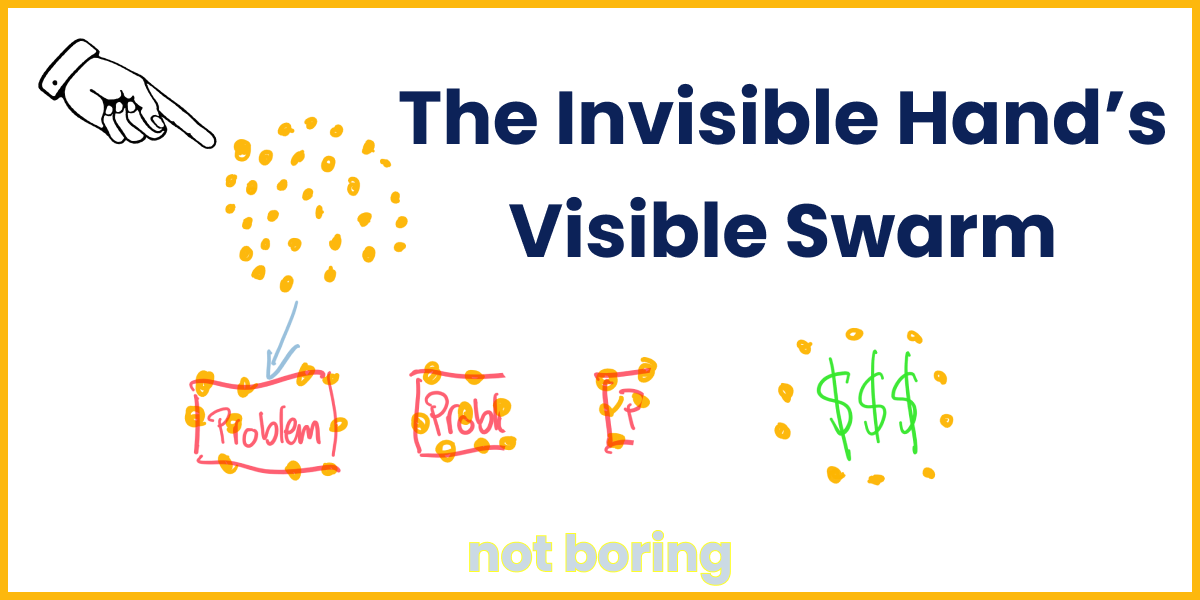
In a March 2022 essay titled Back to the Hereafter, Peter Thiel wrote:
Information technology is a paradox of our fourth dimension that the path to radical progress begins with moderation. Farthermost optimism and fatalistic cynicism may seem to be stark opposites, but they both end in apathy. If things were sure to improve or spring to collapse, then our deportment would non matter one way or the other.
Every bit an extreme optimist, that one made me suspension and reverberate. I retrieve I've squared it. Individual deportment thing securely, merely given enough fourth dimension, the free market is shockingly skillful at directing those individuals' actions and money at tackling the right really hard problems.
(I don't know where else to put this and then I'll put it here: I realize that the government plays an important part – climate tech, space, and fifty-fifty the cyberspace aren't where they are today without the government's involvement, and some problems are all-time solved past the government until new models are adult. Simply this slice is about how free markets work and solve problems, so I'll focus on that.)
And we're getting ameliorate at it as nosotros improve our technology and abound our accumulated noesis. This next decade is going to see unimaginable developments in health, space, economic design, VR, energy, and beyond.
Of course at that place are and will continue to be winners and losers at the individual company level. Some promising technologies will fail. Sure industries will take longer to develop than others. But on a decade-scale and beyond, the market place will somehow effigy out how to put tremendous resources towards the biggest challenges. Which is astonishing, given that nosotros're all just acting selfishly and doing whatever we retrieve gives us the best risk of succeeding.
That doesn't hateful the market is perfect. It's not. In that location are challenges like homelessness with less clear economical upside that will need new models if they're going to be solved via markets. And there are specific cases similar Fast.
Over the past couple of weeks, Twitter has been atwitter about the ascension and fall of Stripe-backed one-click checkout company Fast. To some, Fast is the poster kid for the excesses of venture capital letter, proof that the whole matter is a house of cards. To others, its controversial founder, Domm Holland, is a "homo in the arena," noble for having tried despite, and even because of, his failure.
To me, Fast'south ascent was a glitch in the system, a well-engineered hack of the mode that capital and talent swarm promising opportunities. I find it frustrating that it's now held up every bit an example of what'south incorrect with venture, because it was such an obvious glitch. I'm on the optimistic end about tech companies until proven otherwise, but in April 2021, I wrote, "fifty-fifty though I dear Stripe, I do non empathise its investments in Fast." That's well-nigh as harsh as I become.
But the market corrects. Fast's swift autumn, and redistribution of talent to more productive uses, was a triumph of costless markets. It was probably a tough few days for Fast's employees, who by all accounts were very talented, but the marketplace moved quickly to observe them new homes. Many were acqui-hired by Affirm, the residuum seem to take been snatched up by a market hungry for talented people. Equally the grit settles, the ex-Fast crew will have a fun story to tell at dinner parties, some valuable lessons, and an opportunity to work on unlike bug. Schumpeter's Gale blows again.
But this slice is not about lending my voice to the chorus of dunkers. It's about how resources – talent, capital, energy – swarm the problems that need to be solved. And it'due south almost how to hack the swarm for good.
An Invisible Swarm
One way to call back about entrepreneurship is as the invisible hand's way of directing capital letter and talent towards solving problems, big and modest, that move humanity frontwards. It's the invisible paw's visible swarm.

The swarm is an evolved and highly legible manifestation of Adam Smith's invisible hand, operating a layer up from the pin factory version, orchestrating the search non for equilibrium but for progress.
The biggest challenges – illness, climate, space, inequality, and more – attract a swarm of talent and capital that grinds them downward until they're largely solved. Attract the swarm, solve the trouble, with a lot of messiness, fits, starts, peaks, and of course, bubbles, in between.
Bubbles are usually maligned, just from a "how exercise we throw people and coin at solving our biggest challenges?" perspective, they're incredibly useful. When you lot see a chimera, you're oftentimes seeing the swarm in action. The cumulative efforts of countless swarms are responsible for human progress, even if those swarms can look bubbly and inclement in the moment.
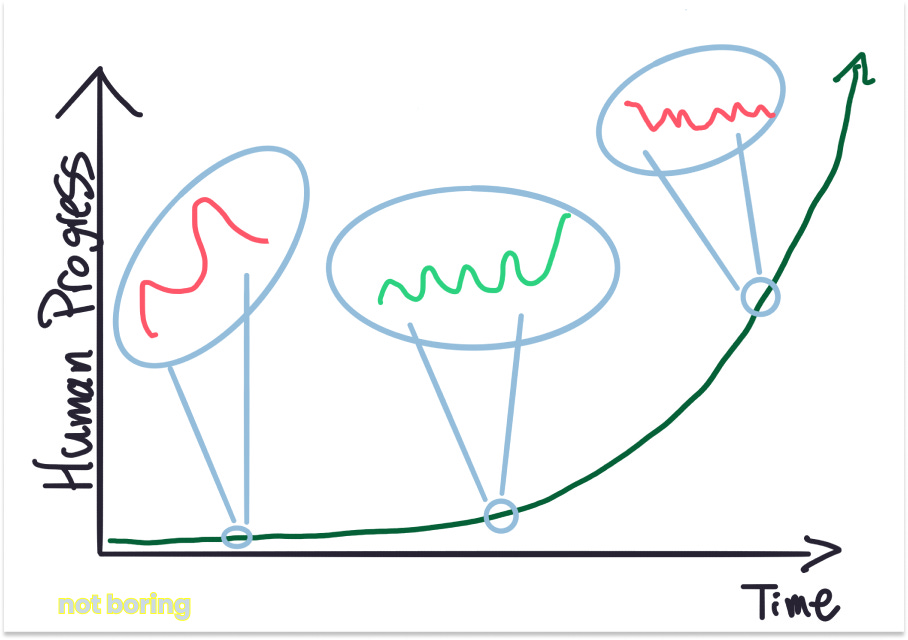
Thanks to a million little bubbling and a growing pile of Legos, homo progress is accelerating. We've talked virtually it before, most clearly in Compounding Crazy. That should mean more volatility as the swarm moves faster and faster, but information technology should also mean that we're knocking downward problems at a higher and college charge per unit.
The challenge, then, isn't fugitive the volatility, but making sure that it'southward being directed at the correct problems. The invisible manus needs to know where to send the swarm.
When Adam Smith began writing nearly an invisible hand, a metaphor for the marketplace's cocky-correcting mechanisms, in 1759, the earth was very local, and information moved at a more leisurely pace. Twitter hadn't been invented nonetheless. There was no TechCrunch or The Information or PitchBook. Venture upper-case letter's predecessor, whaling expedition financing, was still one-half a century away.
And yet, Smith showed that as information spread, talent, capital, and "stock" would move as if guided by an invisible hand to the nearly productive opportunities in a dynamic system. In his examples, that might hateful that the possessor of a pivot factory might need to rent labor to make more pins. His demand would drive up wages in the limited labor pool, which would hurt profits in the curt-term, but higher wages would also increase the supply of labor, bringing wages back down. Remember of information technology like ho-hum-motion surge pricing.
Today, information zips around the world instantly, the talent pool is condign more liquid and global, venture capital has more money to deploy than e'er before, and the scope of the world's ambitions are getting bigger. Ideally, all of this combines into one big matching engine that puts the correct people and uppercase to the correct problems.
How does the swarm know what to set on? In my head, I'thou picturing different problems sending out pheromones to attract the swarm.
The intensity of the bespeak each problem sends at any given time is determined past a bunch of factors, including:
-
Total Addressable Market (TAM)
-
Economics
-
Visibility of the Opportunity
-
Technical Difficulty of the Trouble
-
Market Structure / Barriers
-
Impact
-
Sexiness
-
How Solved the Problem Already Is
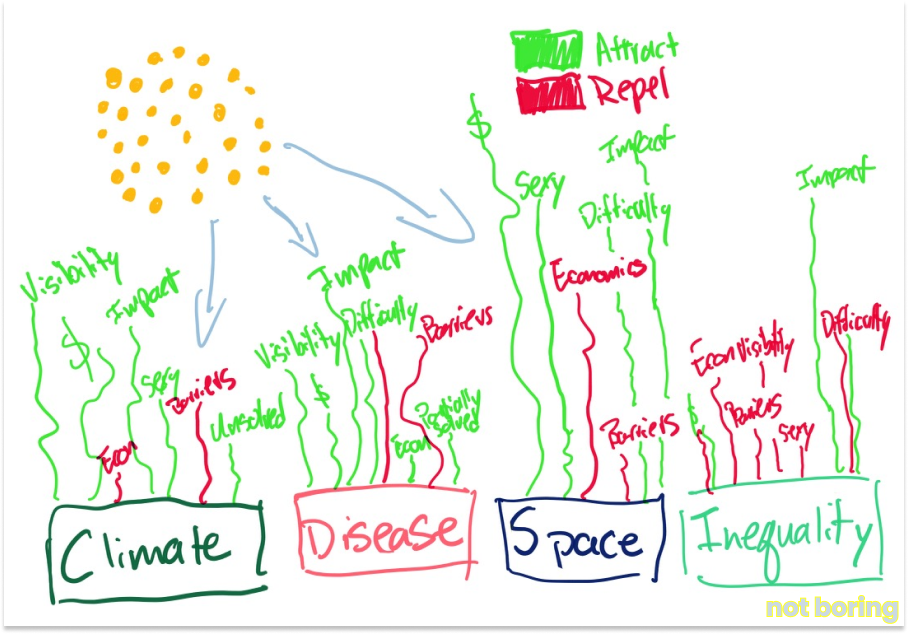
These combine and offset and balance each other, some factors attracting, some repelling. The ones with the highest net attractiveness attract the swarm virtually strongly, but each likewise has its own unique scent which tin concenter certain kinds of people out of the keen global swarm. Over time, every bit the swarm attacks, the book and types of people and majuscule each problem attracts evolves.
The swarm can descend upon whole industries – like climate tech – or specific opportunities – like web3 UX. In either example, the issues that are able to attract and hold the swarm's attention for long enough will undoubtedly get stock-still. This is i of the things that cynics get wrong – the inability to run across that the most obvious challenges are like big flashing FIX ME signs to the swarm.

A bubble – too many adept solutions swarming the obvious issues – is far more than likely than the problem not getting solved!
Non to exist gross, but a swarm's success in solving a problem that it's identified is as inevitable equally those videos in which swarms of ants consume nutrient, like this:
That doesn't hateful that each member of the swarm will succeed, or that the swarm volition behave rationally in the short-term. Often, the contrary is true: swarms are full of humans, and humans tend to get overexcited nearly the things that nosotros get excited about, especially in groups.
It often goes something similar this:
-
A few pioneering people get excited well-nigh solving a problem, either because of its potential impact or just because of the technical claiming. Many fail – these problems are really hard! – but a few succeed. Retrieve Satoshi with peer-to-peer cash, an one-time unsolved problem, or Elon Musk with reusable rockets.
-
When they solve the biggest technical or business model challenges, they alter the pheromone balance, lowering the intensity of the repellants and increasing the intensity of the attractors. The swarm senses opportunity where they didn't earlier, and they wing at the problem… fast.
-
The infinite gets hyped. More people and dollars flood the space than it can reasonably handle because everyone is self-interested and sees like opportunities. They don't coordinate ahead of time, they swarm the market place and compete.
-
While many companies fail and investors lose money, the swarm makes a meaningful dent in the problem that it was trying to solve, in anticipated and unpredictable ways.
This is where the bubbles come up in, and why they're a adept matter. As Byrne Hobart wrote in the fantabulous essay Well-Behaved Bubbles Ofttimes Brand History:
Bubbling tin can be direct beneficial, or at least lead to positive spillover effects: The telecom bubble in the '90s created cheap cobweb, and when the world was ready for YouTube, that fiber made it more than viable.
To stick with the swarm illustration, think of it like worker bees dying to protect the queen. In the long arc of history, information technology doesn't matter which company succeeded or how many sacrificed themselves in the attempt, all that matters is that the swarm solved the trouble.
If that sounds familiar, it's considering the swarm explains the Gartner Hype Cycle. In fact, one way to think about how Hype Cycles happen is that exciting technological or business model breakthroughs send out signals to the swarm that a problem is at present more than solvable, and that there's coin to be made and impact to be had for solving it.
The swarm attacks the problem with more people, companies, dollars, and dreams for the new technology or model until it becomes and so competitive that it's articulate that not everyone volition win and that some of the early ideas were a fiddling dumb. So the weaker office of the swarm, the part attracted more by sexiness or TAM than the technical challenge or bear on, flies abroad while the passionate ones continue building until they have commercially viable solutions that gain traction.
Their success attracts the part of the swarm attracted by a different risk profile, the ones who desire to work on more certain things, once the dust has settled. This is where an manufacture similar B2B SaaS is today, on the Plateau of Productivity, or in what Carlota Perez calls the Deployment Period. Things that once seemed impossible go mundane. Information technology's pretty amazing.

This same pattern plays out over and over, across industries. Companies rise and fall, simply humanity progresses.
The example Byrne provided – the Dot Com Bubble – is a canonical example. The swarm tried a million things, most of which failed, some of which (like Amazon and Google) became wildly successful. Fifty-fifty the failures contributed to bringing the world online in large and small ways. Today, connecting humans beyond the earth with each other, all of the world's data, and an space inventory of things is a solved problem. That'southward wild.
And so the swarm turns its attending to new frontiers, some worthy and some… not. Let'southward look at iii – climate, space, and web3 – that evidence different ways the swarm operates, and how it can exist hacked for practiced.
Climate
In 2007, Kleiner Perkins Partner John Doerr said, "Going greenish is bigger than the Cyberspace. It could be the biggest economic opportunity of the 21st century."
That opportunity attracted Kleiner Perkins enough to commit $200 million to investing in greentech in 2006, and to launch the $500 million Green Growth Fund in 2008. Greentech investing proved famously disastrous for Kleiner Perkins and tarnished the firm'south previously sterling reputation and standing amongst the top tier venture firms.
The biggest trouble was that the economics didn't make sense – renewable energy wasn't toll competitive with fossil fuels, and about people can only be bothered to help salvage the planet when it doesn't toll them anything (no judgment, I'm guilty here too).
But big pools of coin from Kleiner Perkins and others attracted a swarm of entrepreneurs, and those entrepreneurs got to piece of work building new solutions and scaling deployment of existing ones, and over the by decade, the toll of free energy from renewable sources has come down dramatically.
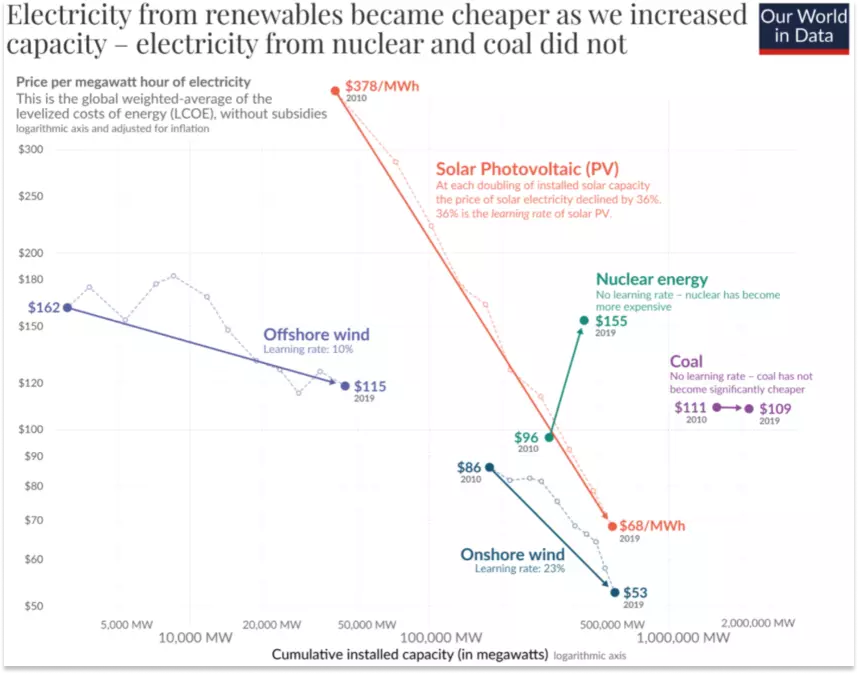
The 2006 menses is often referred to as a "greentech bubble" or "cleantech bubble," with all of the negative connotations that come with the term, only I think a more useful fashion to describe the catamenia is equally the first wave of the swarm.
Sure of the industry's characteristics – TAM, visibility, impact, sexiness, technical difficulty, unsolved problems – attracted a swarm of talent and capital, both of whom were probably a fiddling overly optimistic about their ability to solve some of the manufacture's tougher characteristics – similar economic science – in the brusque-term. But their efforts contributed to grinding down those tougher characteristics and exposing new opportunities.
Similar the Dot Com chimera, the first moving ridge of greentech investing helped build the infrastructure. Private companies, projects, and investors lost money, merely that doesn't really matter to the swarm. What matters is making progress confronting the goal, and the bubble helped make that happen.
Today, a new climate boom is underway. According to PitchBook, venture capitalists invested $31.four billion in climate tech companies, an increase of 68% over 2020.

Climate tech investing didn't abound every bit fast as venture upper-case letter equally a whole did in 2021, but I doubtable that's going to modify. People like Chris Sacca are hacking the swarm for good.
In an interview with Harry Stebbings, Chris Sacca said of his investments at Lowercarbon Capital, "I have multiple companies in the portfolio right at present that have the trajectory to get multi-trillion dollar companies."
The quote rhymes with Doerr's prediction that going light-green could be the "biggest economic opportunity of the 21st century," which may bear witness to exist prescient. The opportunity isn't just defensive – to salvage the planet – simply offensive – to create a shitload of cheap, clean free energy – as Cleo Abram explains well hither:
Climate, which for a while felt like a infinite for hippie do-gooders, now packs a one-two punch that's irresistible to the swarm: bear on and TAM.
Equally the space matures and needs to attract the next wave of the swarm to attack all of the many problems that contribute to rising CO2 levels, champions like Sacca are turning their focus from impact to greed, highlighting the multi-trillion dollar opportunity up for grabs in remaking the earth's energy and replacing aging infrastructure.
Agreement that the second wave of the swarm – the large wave – needs to see the dollar signs, and positioning accordingly, is a brilliant way to hack the swarm for good. Sacca's playing the game on a different level past realizing that this is a problem that needs to be solved, and that at that place's no better way to solve a problem than past alluring the swarm.
I remember that's the deviation between a state of affairs like Fast – which hacked the swarm to focus on one visitor's solution to a relatively unimportant problem – and the approach that Sacca is taking – hacking the swarm to attract it to an entire industry and solve a very important trouble.
No one'south better at doing that than Elon Musk.
Space
In Fount and the Trunk's Magical Future, we covered Tim Urban'due south Elon Musk Company Formula.
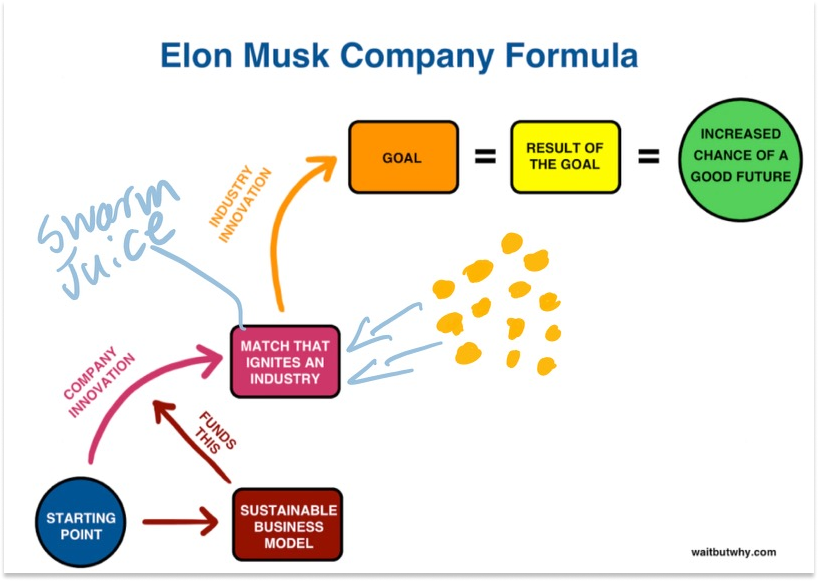
Another mode of framing the formula is that Elon is a master at hacking the swarm for skillful by solving really hard problems at the intersection of technology and business concern model, making the solutions sexy, and pointing the swarm to areas where in that location'due south a lot of money and impact to exist had.
Accept space. Space exploration in the U.s. had been stagnant for decades when Elon Musk launched SpaceX in 2002.
As we discussed in Hadrian: Ex Machina Advertizement Lunam, the US hadn't returned to the moon since its last trip in 1972. It toll $16,000 to launch a kilogram into space on an Atlas Three launch vehicle. Reusable rockets were an unsolved problem. Plus, space exploration was something that government agencies did, not individual companies. Space wasn't just unattractive to the swarm, information technology was barely even visible.
The business case for infinite looked bottomless, but Elon was attracted to 1 item pheromone that stood out above all of the negative signals: touch on.
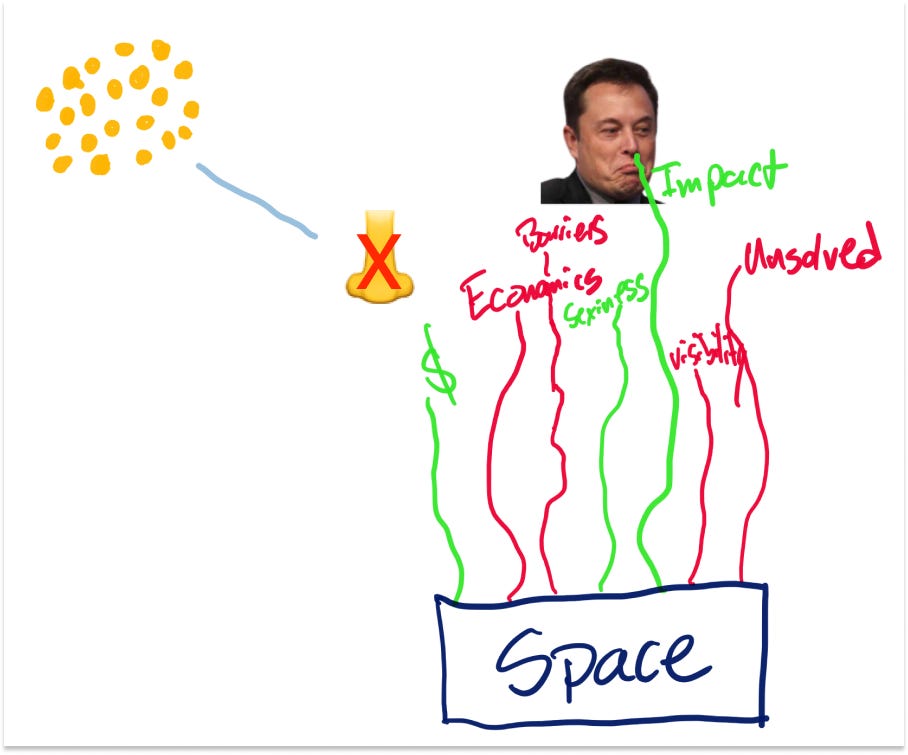
(Funny side note: apparently Elon really does take a heightened sense of aroma.)
Space travel was the simply thing with the potential to brand the human species multi-planetary, which would dramatically increase our odds of survival. And the physics worked: nothing nearly reusable rockets or lower launch costs were physically impossible to solve, merely actually hard.
As Musk'southward ex-PayPal colleague Peter Thiel wrote in that Back to the Time to come essay, "A renaissance will require motivational goals. To be motivational, a goal must exist both aggressive and achievable… For technologists, that means pursuing goals that are hard but possible."
In SpaceX, Elon pursued something that was difficult but possible. Past laying out his vision and plan, he was able to attract the well-nigh audacious and passionate office of the swarm to help make information technology a reality. Over the past two decades, Elon and the SpaceX squad have shown that the aggressive is possible. They've brought downwardly launch costs from $16k/kg to $one,500/kg, and are expected to get it even lower, to $l/kg with the launch of Starship.
In this case, Elon was contrarian and correct, and SpaceX is now a $100 billion private company as a result. By definition, contrarians run into opportunities before the swarm arrives. Being contrarian and right could also be seen as front-running the swarm.
SpaceX has likely secured the biggest prize in this space tech cycle, as information technology should for its counterintuitive contributions to the category. More chiefly from the perspective of progress, information technology opened upward the category to the swarm.
SpaceX has made the economics of infinite engineering science more favorable, and it's also amplified other pheromones for infinite tech. Space is sexier now, the TAM looks bigger, barriers are lower, it'due south more visible, and potential outcomes are bigger. It kicked off a renaissance in space exploration and commercialization.
Elon been then successful in making infinite commercially viable that there are bubbles in certain sub-categories of space tech now. From humanity'due south perspective, that's a phenomenal thing. Talent and uppercase is swarming issues whose solutions might mean multi-planetary life, access to cheaper free energy sources, and new frontiers that allow humanity to proceed to abound.
SpaceX did the near-impossible over the course of two decades in order to finally attract the swarm, which volition now help in the effort to open upwards infinite.
And so Elon hacked the swarm for skillful, and it looks like Sacca is doing the same. What about web3?
web3
The swarm explains why web3 is so controversial. To some, information technology's Fast on steroids. To others, information technology's Elon in smart contract course.
To critics, web3 looks like the ultimate swarm hack: a product with money baked in, designed to attract talent and capital despite having no real impact. To critics, JPEGs of monkeys and incestuous DeFi protocols shouldn't be able to hack the swarm's attending similar they have.

Undoubtedly, there are projects that fit that characterization – unscrupulous money grabs with no real bear upon – but similar Fast, those projects are glaringly obvious to anyone paying attention. To me, these are like businesses calculation ".com" to their name in the late 90s: information technology works when the swarm is in its initial frenzy, it won't over time.
Scams and the other challenges of web3 – UX issues, mini-bubbles in categories like DAO tools, high transaction costs, and more – are classic cynic traps. They're things that critics can point to every bit glaringly obvious shortcomings, only past pointing at them, they're only directing the swarm to solve those problems, like those fun dancing tarmac traffic directors.

In fact, that might be the role of cynics in this whole thing: to uncover opportunities for the swarm and yell about them until they're fixed.
So those will exist solved. The UX will improve. Hacks will be less frequent. Transactions will cost less, and make the space more approachable. The question, and then, is impact, or, "So what?"
I'm bullish on web3 for a lot of reasons that I've written about, merely in this example, the most relevant reason I'thousand excited about web3 is that I think it can exist a key tool in solving another 1 of the swarm'south shortcomings, and possibly its biggest: its lack of interest in issues with no articulate, beginning-guild economical opportunity.
These problems are ones typically left to governments – things similar homelessness and inequality – but that I suspect would be better solved by the market assuming there were a way to align incentives and attract the swarm. This is where I think web3 volition shine, by using tokenomics to better align incentives amidst large groups of people.
To me, this is the promise and potential of web3. That was the thesis of the first essay I wrote this year, The Laboratory for Complex Problems:
A complexity scientist might look at DAOs and NFT communities every bit a serial of real-money, real-incentive experiments that are more authentic to homo nature than anything they could build in a machine, and they would learn what levers to pull in order to coordinate internet-native groups of strangers around shared beliefs and shared missions.
And they might look for ways to use those learnings, and appeal to the same human desires to solve large, circuitous problems in both the digital and physical earth.
The big opportunity for web3 is to provide the tools and incentives to hack the swarm for good, to direct it to work on difficult unsolved coordination challenges that we didn't have the tools to address through markets previously.
That may be through things as simple as internet-scale X Prizes for difficult challenges, with NFTs or tokens as a visible artifact of participation and want to solve a particular problem. Information technology might be through baking money into problems that otherwise might non accept made economical sense in the past. It might be by ameliorate aligning incentives and irresolute the economical equation.
Every bit 1 example, Not Boring Capital letter portfolio visitor Vibe Bio wants to get drugs for certain rare diseases to marketplace by working directly with patient communities. Aligning incentives with patients might shift the ROI math and brand a wider swath of therapeutics commercially viable, and more importantly, available to cure diseases.
As another, which I'll tell you more about next week, the ReFi movement is aiming to lend firepower to the climate fight by building more than sustainable economical models and coordinating economic interests across big groups (and fourth dimension).
In both cases, web3 tools can serve as infrastructure for attracting and analogous the swarm to solve problems across industries.
A Formula for Optimism
This is why I'm optimistic, not considering there aren't whatsoever problems – there are so many issues! they're glaringly obvious! – only because the swarm is attracted to big problems and has proven its power to solve them. Companies come and go, technologies get hyped up and fade abroad, but eventually, the swarm smooths out problems until the sexiest, near challenging things are just boring, normal industries.
Everything that we take for granted today seemed most incommunicable one time, before the swarm got to it.
Looking at Fast, climate, web3, and infinite, I think at that place are merely iii questions that y'all need to enquire to understand whether or non the swarm volition fix an manufacture's shortcomings:
-
Is the problem physically solvable?
-
Is there a path to doing then profitably?
-
Will it affair if it'south solved?
That's it. If any of the answers are no, the cynics are correct. If they're all aye, the optimists are.
In Fast'south case, the answers were yes, yes, no, so when the going got rough, the swarm dissipated.
The space industry is the best at this way of thinking. Robert Zubrin'southward The Example for Space is 408 pages of taking seemingly impossibly futuristic issues (like colonizing Mars, mining asteroids, or traveling to distant stars), breaking them down to their physics and costs, and explaining what volition demand to be truthful for solutions to be possible. Given the near-infinite stakes and potential impact, Zubrin treats even the hardest challenges as a matter of when, not if.
While the laws of the economy aren't equally clean as the laws of physics, I believe that solutions are equally inevitable every bit long equally they answer "yeah" to all three of those questions higher up.
Whether via web3, VC, or skilful old fashioned gratis markets, the swarm is why I'one thousand so optimistic nigh technology and humanity'southward future. It'southward why I'1000 bullish on republic and America, despite the division and seemingly insurmountable challenges.
Yesterday, a16z Partner Katherine Boyle wrote an essay titled The Case for American Seriousness. In information technology, she identifies a pervasive lack of seriousness as 1 of America'southward biggest meta-challenges. Instead of government intervention, she proposes entrepreneurship as the solution. In true Andreessen style, she proposes that Americans demand to build:
Build housing for the middle grade. Build schools for the kids who want to learn math. Build adjacent-generation defence capabilities with young people who grew up coding. Build PCR tests so that a nasal swab stops the nation from closing businesses at the mere sight of Covid case increases. Build trade schools. Encourage men and women to piece of work with their hands again. Cut the red record that stops us from edifice infrastructure fast. Build factories in America. Build resiliency in the supply chain. Build work cultures that support mothers and fathers so they can have more children.
We do not demand aging institutions to pave the fashion for American dynamism. Simply we need American will.
The way I read it is that we demand to do everything possible to let the swarm attack the biggest problems. Some are obvious and are already beingness swarmed. Others need Elons to run into opportunities where others meet walls, Saccas to entreatment to the swarm'south greed for practiced, or web3 tools to align incentives and develop new models where current ones won't quite fit.
Extreme optimism doesn't necessarily lead to apathy. I'm extremely optimistic that the swarm will solve the world's biggest challenges and move humanity forwards, simply the swarm is just the best efforts of billions of people solving the pieces of the problem that they tin can solar day after 24-hour interval until i problem fades and nosotros move on to the next.
Cheers to Dan for editing.
Not Deadening is Hiring!
Nosotros're hiring 2 roles that touch both the media business and venture fund: Atoms Enquiry Annotator and Bits Research Annotator. If you're a smart, curious person with deep noesis nearly any of the categories we discussed today and an ability to write about your space clearly, you lot should apply:
Thanks for reading, and see you lot next week,
Packy
Source: https://www.notboring.co/p/the-invisible-hands-visible-swarm
0 Response to "There It Is Again the Invisible Hand at Work Controling Us"
Post a Comment